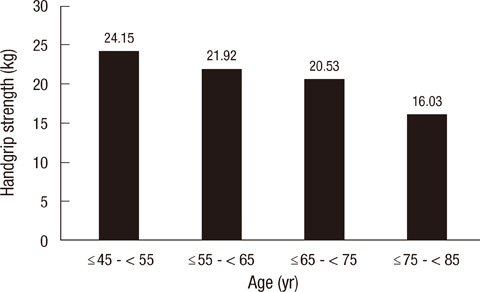J Korean Med Sci.
2012 Jul;27(7):744-747. 10.3346/jkms.2012.27.7.744.
Low Handgrip Strength is Associated with Low Bone Mineral Density and Fragility Fractures in Postmenopausal Healthy Korean Women
- Affiliations
-
- 1Department of Internal Medicine, Kangwon National University School of Medicine, Chuncheon, Korea. ehcho@kangwon.ac.kr
- 2Department of Obstetrics and Gynecology, Kangwon National University School of Medicine, Chuncheon, Korea.
- KMID: 2157917
- DOI: http://doi.org/10.3346/jkms.2012.27.7.744
Abstract
- Osteoporosis is a widely recognized health problem in postmenopausal women. Osteoporotic fractures reduce independency, limit daily living activities, and increase the mortality rate. Epidemiological studies have demonstrated that low handgrip strength is a risk factor for functional limitations and disabilities, and all-cause mortality. We investigated the relationship between handgrip strength and bone mineral density (BMD) of the spine, femur neck, and total hip, as well the relationship between handgrip strength and previous fragility fractures in 337 healthy postmenopausal Korean women (mean age of 59.5 +/- 6.8 yr) who were free of diseases or medications affecting bone metabolism. Age and handgrip strength were associated with BMD of the spine, femur neck, and total hip in multiple regression models. Low handgrip strength (odds ratio [OR], 0.925; range, 0.877 to 0.975; P = 0.004) and low femur neck BMD (OR, 0.019; range, 0.001 to 0.354; P = 0.008) were independent predictors of previous fragility fractures in a multiple regression model. Our results demonstrate that low handgrip strength is associated with low BMD of the spine, femur neck, and total hip, and with increased risk of previous fragility fractures.
MeSH Terms
-
Aged
*Bone Density
Female
Femur Neck/physiopathology
Fractures, Bone/epidemiology/*etiology/physiopathology
*Hand Strength
Hip/physiopathology
Humans
Middle Aged
Odds Ratio
Osteoporosis/complications/physiopathology
Postmenopause
Predictive Value of Tests
Republic of Korea/epidemiology
Risk Factors
Spine/physiopathology
Figure
Reference
-
1. Norman K, Stobäus N, Gonzalez MC, Schulzke JD, Pirlich M. Hand grip strength: outcome predictor and marker of nutritional status. Clin Nutr. 2011. 30:135–142.2. Dixon WG, Lunt M, Pye SR, Reeve J, Felsenberg D, Silman AJ, O'Neill TW. European Prospective Osteoporosis Study Group. Low grip strength is associated with bone mineral density and vertebral fracture in women. Rheumatology (Oxford). 2005. 44:642–646.3. Kröger H, Tuppurainen M, Honkanen R, Alhava E, Saarikoski S. Bone mineral density and risk factors for osteoporosis: a population-based study of 1600 perimenopausal women. Calcif Tissue Int. 1994. 55:1–7.4. Lindsey C, Brownbill RA, Bohannon RA, Ilich JZ. Association of physical performance measures with bone mineral density in postmenopausal women. Arch Phys Med Rehabil. 2005. 86:1102–1107.5. Foley KT, Owings TM, Pavol MJ, Grabiner MD. Maximum grip strength is not related to bone mineral density of the proximal femur in older adults. Calcif Tissue Int. 1999. 64:291–294.6. Bayramoğlu M, Sözay S, Karata M, Kilinç S. Relationships between muscle strength and bone mineral density of three body regions in sedentary postmenopausal women. Rheumatol Int. 2005. 25:513–517.7. Albrand G, Munoz F, Sornay-Rendu E, DuBoeuf F, Delmas PD. Independent predictors of all osteoporosis-related fractures in healthy postmenopausal women: the OFELY study. Bone. 2003. 32:78–85.8. Garcia PA, Dias JM, Dias RC, Santos P, Zampa CC. A study on the relationship between muscle function, functional mobility and level of physical activity in community-dwelling elderly. Rev Bras Fisioter. 2011. 15:15–22.9. Choquette S, Bouchard DR, Doyon CY, Sénéchal M, Brochu M, Dionne IJ. Relative strength as a determinant of mobility in elders 67-84 years of age. A nuage study: nutrition as a determinant of successful aging. J Nutr Health Aging. 2010. 14:190–195.10. Theou O, Jones GR, Jakobi JM, Mitnitski A, Vandervoort AA. A comparison of the relationship of 14 performance-based measures with frailty in older women. Appl Physiol Nutr Metab. 2011. 36:928–938.11. Martin S, Neale G, Elia M. Factors affecting maximal momentary grip strength. Hum Nutr Clin Nutr. 1985. 39:137–147.12. Young DR, Masaki KH, Curb JD. Associations of physical activity with performance-based and self-reported physical functioning in older men: the Honolulu Heart Program. J Am Geriatr Soc. 1995. 43:845–854.13. Rantanen T, Guralnik JM, Foley D, Masaki K, Leveille S, Curb JD, White L. Midlife hand grip strength as a predictor of old age disability. JAMA. 1999. 281:558–560.14. Taekema DG, Gussekloo J, Maier AB, Westendorp RG, de Craen AJ. Handgrip strength as a predictor of functional, psychological and social health. A prospective population-based study among the oldest old. Age Ageing. 2010. 39:331–337.15. Ling CH, Taekema D, de Craen AJ, Gussekloo J, Westendorp RG, Maier AB. Handgrip strength and mortality in the oldest old population: the Leiden 85-plus study. CMAJ. 2010. 182:429–435.16. Rantanen T, Harris T, Leveille SG, Visser M, Foley D, Masaki K, Guralnik JM. Muscle strength and body mass index as long-term predictors of mortality in initially healthy men. J Gerontol A Biol Sci Med Sci. 2000. 55:M168–M173.17. Ock SM, Choi WS, Song CH. The relationship between grip strength and femoral and vertebral bone mineral density in peri- and postmenopausal women. J Korean Acad Fam Med. 1999. 20:377–385.
- Full Text Links
- Actions
-
Cited
- CITED
-
- Close
- Share
- Similar articles
-
- High Serum Osteopontin Levels Are Associated with Low Bone Mineral Density in Postmenopausal Women
- The relationship between grip strength and femoral and vertebral bone mineral density in peri-and postmenopausal women
- The relationship between grip strength and radius bone mineral density in postmenopausal women
- Pharmacological Therapy for Postmenopausal Osteoporosis
- Bone Mineral Density and Prevalence of Osteoporosis in Postmenopausal Korean Women with Low-Energy Distal Radius Fractures


